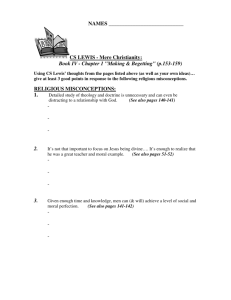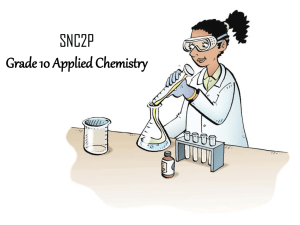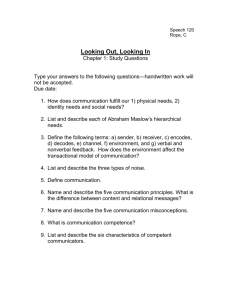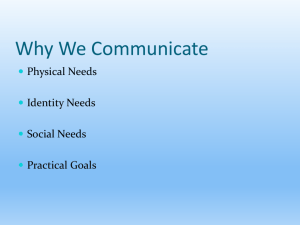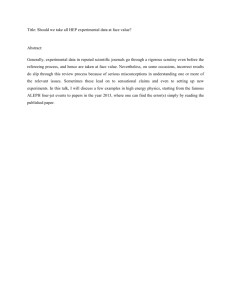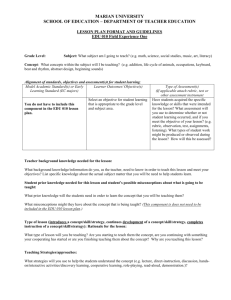session 7 Student Misconceptions
advertisement
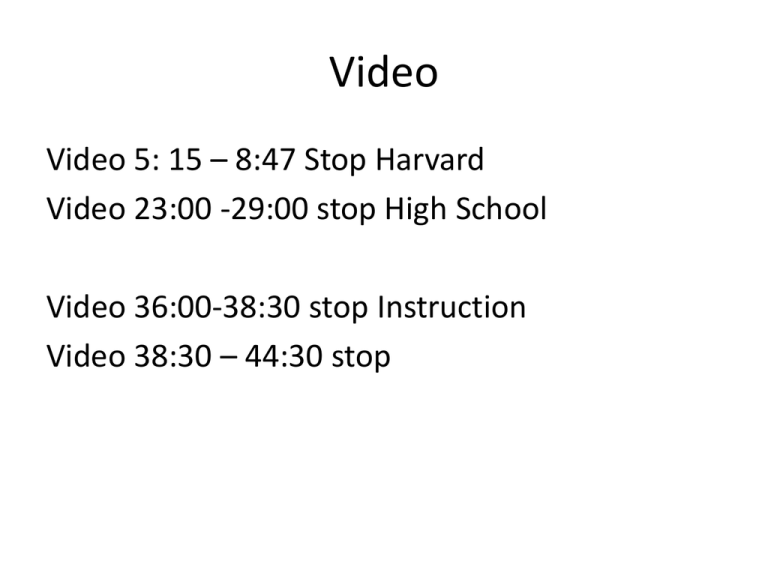
Video Video 5: 15 – 8:47 Stop Harvard Video 23:00 -29:00 stop High School Video 36:00-38:30 stop Instruction Video 38:30 – 44:30 stop TfR Seminar: Session 7 Misconceptions in Science Do Now! (3 min) • Take out all session 7 Handouts, please! • (3 min) Review HO 7.1- Prepare for discussion • Reflect on the following questions: 1. What was your understanding of the cause of the seasons, before viewing this video? 2. What are the causes of scientific misconceptions? 3. How difficult is it to clear up student misconceptions? 4. What role do student misconceptions play in shaping instruction? WRITE YOUR ANSWER TO THE 1st QUESTION on the index card (5min) Reflection Shuffle • I will shuffle the cards and redistribute them • Each person reads the card they were given, aloud. “Reflection shuffle” is a method of voicing every student’s ideas – It provides an engaging way for students to listen to their peers. Session Agenda Time Activity 5:00- 5:10 10 minutes Opening 5:10- 6:20 70 minutes Section 1 BREAK 6:30- 7:10 40 minutes Section 2 7:10-7:45 35 minutes Section 3 7:45-8:00 15 minutes Closing Introducing Scientific Misconceptions Strategies for Identifying and Redirecting Misconceptions in Science Implementing Effective Strategies for Student-Generated Questions Analyzing Posttest Data and Adjusting Instruction Reflection Session Objectives • EXPLORE misconceptions in science and the strategies that uncover student preconceptions, redirect student understanding, and teach for conceptual change. • EXAMINE and select effective strategies for teaching students to ask questions about the material world. • EVALUATE content assessment results to make strategic decisions about re-teaching. • REASSESS content domain knowledge and compare to first self-assessment. Transition • In the next section, we will continue to use HO 7.1 and your reflections on the video as a way to examine student misconceptions in science and discuss how teachers must adjust instructional planning and delivery to redirect misconceptions. • We will then identify instructional strategies that we can use to detect misconceptions and to teach for conceptual change. Session Agenda Time Activity 5:00- 5:10 10 minutes Opening 5:10- 6:20 70 minutes Section 1 BREAK 6:30- 7:10 40 minutes Section 2 7:10-7:45 35 minutes Section 3 7:45-8:00 15 minutes Closing Introducing Scientific Misconceptions Strategies for Identifying and Redirecting Misconceptions in Science Implementing Effective Strategies for Student-Generated Questions Analyzing Posttest Data and Adjusting Instruction Reflection Section 1: Strategies for Identifying and Redirecting Misconceptions in Science Shoulder Share ( 3 min) 1. What are the causes of scientific misconceptions? 2. What is the challenge in clearing up student misconceptions? 3. What role do student misconceptions play in shaping instruction? Be prepared to share out findings Share Out (10 min) • One person from each pair shares out most important findings (1min) Shoulder Share • Discuss your findings on HO 7.1 (2 min) – Add ideas as appropriate • Complete 7.2 together (3 min) • Be Prepared to share out Chart Responses Complete the chart to debrief the way teaching and learning are depicted in the video. • Equity sticks Strategies for uncovering Strategies for redirecting misconceptions and misconceptions and preconceptions teaching for conceptual change Metacognition • The learning experience depicted in the video illustrates how students hold hard and fast to their preconceptions. • This scenario is just one example of the many challenges that face you in the science classroom related to student misconceptions. • Book Resource: – Making sense of secondary science: research into children's ideas Video In The Science Classroom • Can be a powerful tool. • Students can see scientific phenomena that may be very difficult to replicate in the classroom. • Video also enables the viewer to conceptualize processes and changes that take extended observation or expensive equipment to view in real time. • Teachers can ensure that student learning from video is maximized by: – setting a clear purpose for viewing – providing scaffolded or guided note-taking forms – pausing the video to probe students for understanding and to allow them to reflect on what they have learned. Transition • INSTRUCTIONAL KEY MESSAGE • Teachers’ instructional choices must be informed by students’ prior knowledge and misconceptions. • Teachers must help their students use their science process skills to master content knowledge. • It is critical that teachers be able to uncover student misconceptions to teach for true understanding. • Students’ preconceptions and misconceptions limit any accurate learning. • We will now experience a lesson that displays strategies to both detect misconceptions and redirect for conceptual understanding. MODEL Adaptation Lesson • After experiencing the lesson, you will engage in strategies to help teach for conceptual understanding. • Many people, even those people who have studied university level biology, cannot accurately explain adaptation as it relates to populations. • This activity can be done at the middle school level, focusing on the macro-scale (visible change to a population over three generations), or at the high school level, where the concept of adaptation is linked specifically to genetic variation and natural selection. • Participants will take on the role of students in this activity to model how it might be presented to students. – Pay attention to probing for and redirecting misconceptions about adaptation throughout the activity. APK • Silently consider how your students might answer the following: (1min) – How does adaptation happen? – What causes a population to change a characteristic or trait over time? Peppered Moths in England • Take out Handout 7.3 • Background Info: Preindustrial vs. Postindustrial England – Moths in preindustrial England were mostly lightcolored – Moths in Postindustrial England were mostly darkcolored • Before the industrial age, the tree bark was much lighter in color as seen in image A. • The industrial age brought with it pollution, which can be seen as the dark-colored tree bark background in image B. Student Partner Share (2 min) • What eats peppered moths? How might moths avoid being eaten? • How would you explain why the majority of peppered moths in England during the preindustrial age were the light color (as in image A) but the majority of peppered moths in England during the industrial age were the dark color (as in image B)? • Write your answers in your scientists notebook “Novel Ideas” Share (3min) • What hypotheses would your students generate? • Share only ideas not previously mentioned. Stepping out of the teacher/student role, reflect on this initial activity. • What background knowledge do students need to analyze the images? • How would this exercise allow a teacher to uncover the students’ misconceptions? Returning to Our Role Play (4min) • Examine the pictures – Note that the background represents the color of most tree bark during each era • A - preindustrial • B – postindustrial • What are some general observations of the pictures? • Which of the moths is at greatest risk for predation in picture A? In picture B? • Which would be most likely to survive? Why? • What causes the different colors? • How would predation impact the population of moths? Stepping Out to Reflect • How might student understanding of adaptation be changed at this point? Continuing the Teaching and Learning About Adaptations • The next activity will demonstrate the concepts of variation, the role of genetics in variation, and the differing survival chances of separate variations. Restate Background: • Coloration is important, in the case of the peppered moths, to avoiding predation. • The relationship between environmental change and changes in the greater population (not individual organisms) happens over time. (This restates what some students may be able to articulate from images A and B, knowing that not all students would understand these concepts.) Materials per Pair ■ One sheet of white paper ■ Newspaper ■ Forceps ■ Colored pencils ■ Timer (or watch with a second hand) ■ 30 newspaper circles (made with hole punch) ■ 30 white circles (made with hole punch) Directions • Participants will simulate what happened to the peppered moth population during the industrial period in England. • With partners, they will pick out “prey” from two different environments, represented by the white paper (pre-industrial England) and the newspaper (industrial England). Take out HO 7.4 • Predict what will happen to the peppered moth population during the simulation of preindustrial England. Talking with your partner, record your predictions in box 1. ( 2 min) • Volunteers Share out predictions (1 min) • Review the procedure and data charts (CFU) Pre-industrial England • White paper simulates clean environment • (2 min) Complete 1st generation data • (3 min) Repeat for the next 2 generations and complete the data table Industrial England • Predict what will happen to the peppered moth population during the simulation of Industrial England. Talking with your partner, record your predictions in box 2. ( 2 min) • ( 3 min) Complete the predation process for Industrial England and complete the charts Now Represent The Data Graphically Discuss the following with your partner and construct a graph. (4 min) • What do you need to communicate with the graph? What information do you need to show about the peppered moth adaptation? • Should you use a bar or line graph, and why? • How will you differentiate between preindustrial and industrial England on the graph? • What else will you record on the graph so it is a complete graph? Conclusion • Discuss with your partners whether your predictions about natural selection were correct or not. Debriefing the Activity ( 5min) • How does the simulation model natural selection and adaptation for students? • How does the simulation redirect student misconceptions about predation, variation, and adaptation? • How would you modify the activity, and similar activities, to meet the needs of your students? • What are the limitations of this model in simulating natural selection? Transition • We have examined misconceptions in the science classroom seen in “A Private Universe” and in our own classrooms, and also have just explored a lesson in uncovering misconceptions and teaching for conceptual understanding in peppered moth adaptation. • We will now deconstruct a lesson plan that attempts to detect misconceptions and redirect students’ understanding of a scientific concept. BREAK TIME!!!!! • 5 minutes! Teaching for Conceptual Change (10 min) • Take out the lesson plan on Handout 7.5. • This is an example of intentionally implementing strategies to detect misconceptions and redirect student understanding to help students change their understanding in the long term. • ( 4 min) Analyze the lesson plan and identify any strategies it includes to detect misconceptions and reteach students. – Mark a “D” next to sections of the lesson plan that are strategies in detecting misconceptions – Mark an “R” next to sections of the lesson plan that are strategies for re-teaching the concept. Reflect and Volunteer Share (1 min) • What have you learned from analyzing this lesson plan, and how will you apply this learning to your own planning. Transition • To develop a deep understanding of concepts in science, students must gather correct information and process that information. – Inquiry and investigation help students to understand and correct misconceptions about science concepts. • The process skills of asking questions and collecting and representing data in a graph helped students grasp the mathematical explanation of adaptation. • Next, we will explore the process skill of asking questions and will work through a few strategies that teach students to ask questions. – a first step in beginning to correct misconceptions and develop a deep understanding of science concepts. Session Agenda Time Activity 5:00- 5:10 10 minutes Opening 5:10- 6:20 70 minutes Section 1 BREAK 6:30- 7:10 40 minutes Section 2 7:10-7:45 35 minutes Section 3 7:45-8:00 15 minutes Closing Introducing Scientific Misconceptions Strategies for Identifying and Redirecting Misconceptions in Science Implementing Effective Strategies for Student-Generated Questions Analyzing Posttest Data and Adjusting Instruction Reflection Section 2: Implementing Effective Strategies for Student-Generated Questions • Note the relationship between the science process skills and the content topics on the Content Domain graphic • In this session, Session 8, and Sessions 10–13, we will learn and apply strategies for developing the science process skills. • In A Private Universe, the peppered moth activity, and the forces lesson plan we read in Section 1, the teacher asked questions to probe for student understanding. • To learn about the workings of the physical as well as a designed world, asking questions is paramount. • Students will need to be skillful at asking questions and be able to probe for information, evidence, and reasons. The Strategy Routine • We will begin by experiencing two strategies that teach students to ask questions: picture inquiry and demonstrating “What if?” • The first strategy: Picture inquiry. • Asking Questions with Picture Inquiries (15 min) Explaining the Strategy • Secondary science students must often derive information and draw conclusions from pictures or visuals such as graphs, diagrams, and charts. This strategy helps them with that in two ways: • First, students clarify their understanding by asking questions about the visual that have explicit, literal answers; • Then students ask questions about the visual that have more implicit and under-the-surface meaning. – This step reaches deeply into how the student thinks about the information being presented, the connections and applications the student can make about the information. Understanding the Strategy • Students use the same explicit and implicit questioning that we learned in Session 3; however, instead of using their questions to make meaning from a text, students make meaning of visuals. • Determine which question is explicit and which is implicit, and why: – What color(s) am wearing? – Why did I choose to wear this color? • Assemble into your Strategy Routine Groups Practicing the strategy • We will do three things to practice this strategy of asking questions: STEP 1. Examine the chart and graph on Handout 7.6 and write down observations in the box. (1 min) to discuss and write in your group – Write the statements on Handout 7.6 where it says, “Observations.” – These statements should be factual “on the- surface,” so that anyone reading the chart or graph would agree with each statement and can physically point to the answer/observation – Note the example Share Observations • Share your statements about ozone pollution. Quality Questions • Evaluate the quality of the example explicit and implicit questions on Handout 7.6 and explain your judgment. • Volunteer : Record the ideas about the criteria for quality questions on chart paper. Next steps in strategy (3 min) 2. Write down four explicit questions about the chart and graph of ozone pollution. – no answers, just questions 3. Write down four implicit questions about the chart and graph of ozone pollution. – no answers, just questions Answering • (3 min) Exchange papers with a different group and answer both the explicit and implicit questions in the right columns. – for the implicit questions, list how you would find out the answer rather than answering the question. • (2 min)Return papers and Provide Feedback using the criteria. Evaluate whether the questions are targeted, insightful, and prompt deeper investigation. Brainstorm (1 min) • Brainstorm specific graphs, diagrams, and charts with which you may use this strategy for an upcoming or current unit. Asking Questions with Demonstrating “What If?” • 2nd strategy to support students in asking questions; “What if” (2 min) • Students derive information and ask questions about demonstrations that have a “before” component and an “after” component. • Students use the same strategy as explicit and implicit questions, – However, students make meaning of the demonstration by; • Practicing skills in observation • And asking questions such as what, how much, when, where, and how do we know. • This activity takes the same practice in literacy and comprehension skills from Session 3 and applies them to a lab scenario. The Strategy • You will practice this strategy of asking questions by writing down observation notes and explicit and implicit questions about a demonstration of putting an egg in both fresh water and then salt water. • You will have an opportunity to give and receive feedback on the questions you generate – you need to provide this opportunity to your students when they are first learning how to ask questions. – Students will need feedback on the quality of their question if they are to ask appropriate, targeted, and insightful questions. Demonstration (3 minutes) • Draw or describe what you see on Handout 7.7a under “Observations.” • Write three explicit questions and three implicit questions about the demonstration in the charts on Handout 7.7a. – Note the examples on the handout • You are only writing the questions and not the answers. – The answers to the explicit questions should be clear from the demonstration. – The implicit questions will not have an answer right now; answering them will require steps beyond the demonstration. • In the right column, record how you could find out the answer to the implicit questions. Equity Share and Feedback (2 min) • Share – Show or describe your statements and explicit and implicit questions. • Feedback: – Use the chart of criteria for quality questions created to give feedback on the responses • ensure that all of the statements are observations of the demonstration set up and not interpretations. “After” Demo: Prediction (1 min) • Salt will be added to the water. • What will happen? – draw or describe your prediction on Handout 7.7b in the “Prediction” box “After” Demo Observations • (2 minutes) Draw or describe the “after” demonstration set up on Handout 7.7b under “Observations.” • Write three explicit questions and three implicit questions about the demonstrations in the charts on Handout 7.7b. – Note the examples in the chart Partner Share and Feedback • Trade your Handouts 7.7a and 7.7b with a partner. • Then fill in the right columns • Next, use the chart of criteria for quality questions to give your partner feedback – Were the observations descriptive and not interpretive? – Were the questions correct? Questioning Feedback • Show or describe your observations as well as your explicit and implicit questions. • Share the feedback – Were the drawings and observations of the demonstration objectively descriptive and not interpretive? – Can the explicit questions be measured and answered easily? – Do the implicit questions prompt ideas for further discovery? Volunteer Share (1 min) • Share your ideas as to the benefits of this strategy. Strategy Routine: Selecting Strategies for Teaching Questioning • Silent Read (1 min) • As you learn new strategies to teach the science process skills, think about what the lab report data tells you about student performance. • The next step is for you to review the strategy overview chart on Handout 7.8. (take it out) • This chart outlines strategies for bolstering student process skills in asking questions. • Use students’ process skill data from lab reports along with plans for upcoming labs to direct your selection of the instructional strategy you will implement. Strategies Review • (8 minutes) Pair up with someone who teaches roughly the same science course as you do – Each person takes responsibility for half of the strategies. – Read your half and summarize them for your partner. • Think about how the strategies relate to what you are already doing in class as you share. Transition • Note: You will complete the planning sheet on Handout 7.9, implement the strategy you chose, and fill out the reflection sheet on Handout 7.10 for homework. • We will now analyze posttest data from the same topic of study from Session 4. Session Agenda Time Activity 5:00- 5:10 10 minutes Opening 5:10- 6:20 70 minutes Section 1 BREAK 6:30- 7:10 40 minutes Section 2 7:10-7:45 35 minutes Section 3 7:45-8:00 15 minutes Closing Introducing Scientific Misconceptions Strategies for Identifying and Redirecting Misconceptions in Science Implementing Effective Strategies for Student-Generated Questions Analyzing Posttest Data and Adjusting Instruction Reflection Section 3: Analyzing Posttest Data and Adjusting Instruction • Meet with your course-alike groups for the data analysis. ( 30 sec) • Take out your posttest and the data you recorded on Handouts 7.11b and 7.12b. • Refer to Handout 7.13: Steps for Analyzing Posttest Data. • We will use these steps to analyze your posttest data to determine the next steps needed to ensure that all of your students master the key concepts. • Lets look at the example first! Example Walk-through • Read steps 1–3 on Handout 7.13 – Record these steps on the sample Handout 7.14a, using the information below. • The first step/row refers to the percentage growth by standard as seen in the two columns “Pre” and “Post” for each standard. – In this case of the sample data from Mr. Taylor’s class, the prerequisite standards grew from 60 percent to 68 percent and Standard 1 grew from 30 percent to 76 percent. Step 2 • The second step/row refers to any patterns or trends about the questions on the posttest as seen in the last row “Total % of students who answered each question correctly” on Handout 7.11. – For example, many of the questions that less than 50 percent of the students answered correctly involved math (questions 2, 15, 16, and 20). Step 3 • The third step/row refers to instructional materials and strategies that were utilized for this unit. – For example, Cornell notes and vocabulary organizers were used to teach all three standards but a hands-on project where students drew and built a model of the atom was used only with Standard 1. Your Turn: Steps 1-3 • (15 minutes) Focus on two standards you assessed on the test. • Complete steps 1–3 for the posttest data on Handout 7.14b. • Suggested time limits: – Step 1–2 minutes – Step 2–6 minutes – Step 3–7 minutes NOTE: You will analyze the results for all the standards for homework. Highlights of Findings • (1 min) Equity Stick Share – Significant trends and findings Continuing the Analysis: Step 4 • Read steps 4–5 on Handout 7.13. • Note the chart on Handout 7.14a • The fourth step/row refers to the students who did not meet grade-level expectations on a given standard. • In the example, not meeting expectations has been determined to be 60 percent or less. – Curtis, Elena, Greg, Ignacio, and Jackie scored 60 percent or less for the questions related to Standard 2 and will be targeted for extra support for Standard 2. Step 5 • The fifth step calls for you to create plans for each group of students needing support with each standard. • In Mr. Taylor’s case, due to the reality of limited time in a given school year and day, Mr. Taylor will not be able to reteach every standard to mastery to each student. He will need to prioritize. – Look at each standard and determine how foundational it is to student understanding of the upcoming content and skills in this subject. – Then determine the minimum knowledge base and skills represented by these standards and focus on those as targeted areas of improvement for the struggling students. • Mr Taylors Example follows Step 5 Continued • For example: – To give extra support to Curtis, Elena, Greg, Ignacio, and Jackie, Mr. Taylor is planning to add to the vocabulary graphic organizer to help these students learn more atomic symbols that are used in the chapters that follow on chemical bonding and acids/ bases. – He will also assign review work related to atomic mass, number, and symbols for homework as they move into the next unit of study to help reinforce what they have learned. • Mr. Taylor determines that he will not reteach the historical perspective of atoms or isotopes when considering extra support for the struggling students. Your Turn • (10 minutes) Complete steps 4–5 for the same two standards you have already analyzed on your posttest data and record your thoughts on Handout 7.14b. • You will need to continue your reflection for the remaining standards at home. Share Out • (2 minutes) Equity cards share • Explain one way you are going to provide the extra support to your struggling students. Transition • The analysis you just did is an essential step in the inquiry process that you must always remember. – Even though a unit of study may be done, you must revisit or reteach concepts that your students did not master. • Although you will not be asked to bring in more evidence on your students’ mastery of the tested concepts for this course, you should continue to teach and assess concepts not mastered. Session Agenda Time Activity 5:00- 5:10 10 minutes Opening 5:10- 6:20 70 minutes Section 1 BREAK 6:30- 7:10 40 minutes Section 2 7:10-7:45 35 minutes Section 3 7:45-8:00 15 minutes Closing Introducing Scientific Misconceptions Strategies for Identifying and Redirecting Misconceptions in Science Implementing Effective Strategies for Student-Generated Questions Analyzing Posttest Data and Adjusting Instruction Reflection Professional Goals Check-in • (5 minutes) take a few minutes to check in on your professional goals for teaching science that you recorded on Handout 2.2. • Consider what you have accomplished thus far and note any progress or potential changes to your goals or plans in the “Check-In #1” column. • Share with a neighbor any changes in your professional growth plans. • For example, you may now be working with a collaboration group within the district or with a local science center that you may not have considered doing when you first set your plans back in Session 2. Closing • Review Objectives – How were they met? • Review Instructional strategies – Record notes for future use on Handout 1.8: Instructional Strategies Log. • ( 3 min) Complete session reflection Preview Session 8 : We will focus on unifying concepts in science, specifically form and function, as well as the science process skill of planning investigations. Home Work Assignments ■ Complete HO 7.9, implement the strategy, and complete HO 7.10. ■ Bring in evidence of the strategy lesson, prepared to discuss it at the beginning of Session 8. ■ Use HO 7.14b to finish creating a plan to reteach key concepts. Begin implementing the plan. ■ Complete HO 8.3 using HO 8.2: National Science Education Standards and Unifying Concepts. For Session 9: ■ Assign students to conduct an investigative lab activity and write a lab report before Session 9. ■ Score the second lab reports using rubrics provided by this course, using a highlighter to facilitate data analysis, and record the scores on the data tracker. ■ Bring a printout or electronic copy of the data tracker. ■ Select students who need intensive support. For these students, bring samples of student work, including their lab reports, with the rubrics.
